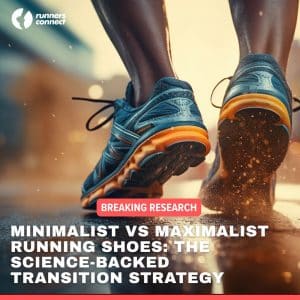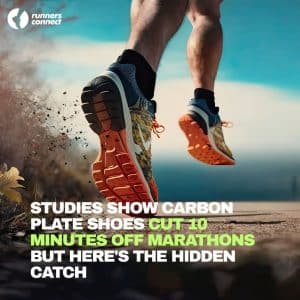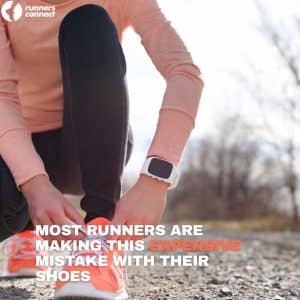Super shoes are the biggest shoe innovation in recent memory—and probably the biggest technological revolution in running since the invention of synthetic rubber tracks.
In case you’re not familiar, super shoes is a general term for stacked foam, carbon-plated shoes (like the Nike ZoomX Vaporfly Next% 3, HOKA ONE ONE Rocket, Adidas Adios Pro, and more) designed specifically to provide a propulsive, spring-like feel that makes you more efficient.
After the first super shoe burst onto the scene in 2017, a raft of scientific research has confirmed that these shoes reduce the energetic cost of running, allowing you to run faster for the same effort level.
The empirical benefits of super shoes are clear, but what about more practical guidelines on how to actually use super shoes for training and racing?
That’s an area where a lot of runners still have lingering questions. Fortunately, research in the last few years has started to fill in these gaps.
And that’s what we’re going to cover today.
- Do super shoes wear out faster than normal shoes?
- As they get worn down, what does this do to their effectiveness?
- Does training in them also improve performance?
Do super shoes wear out over time?
Most of the benefit of a super shoe is in the foam.
Indeed, even if you cut the carbon fiber insole into several pieces using a saw, the energy savings of the shoe are barely affected (cite)!
The importance of the foam itself for the energy savings of a super shoe naturally leads to questions about the “lifespan” of a super shoe: how many miles can you put on it before the foam deteriorates?
Some initial testing on a single pair of Nike shoes by Dustin Joubert, a professor at Stephen F. Austin State University, suggested that even several hundred miles of running didn’t affect energy return to a significant degree.
However, a larger study on prototype shoes from On Running, done by researchers in Spain, suggests that more volume does cause a deterioration in super shoe performance.
The study, done on 22 runners, compared brand-new super shoes to a standard pair of trainers (with “non-super” foam), both when the shoes were brand-new, and when they had 280 miles of wear.
When the shoes were brand-new, the super shoes had a 2% energetic benefit compared to the standard shoes. However, after 280 miles of running, the benefit disappeared completely!
Now, there are a few caveats to these results. First, the standard trainers were designed to be identical to the super shoes aside from their midsole foam, so these standard trainers still had a carbon fiber plate, and weighted the same as the super shoe.
In practice, most standard trainers don’t have a carbon fiber plate, and are heavier than a super shoe, so even a worn-out super shoe may offer some benefit over your usual trainers.
Second, this study tested On Running shoes specifically, and it’s likely that other shoe brands have foam that deteriorates at different rates (possibly faster or slower).
Since each shoe company’s proprietary recipe for “super foam” is a trade secret guarded with the same vigilance as the Coca-Cola recipe, it wouldn’t be very surprising to see differences in foam deterioration between brands.
Evidence on this front comes from the fact that different shoes have measurably different energetic benefits, according to earlier research done by Dustin Joubert, which points to different companies using foam with quite different material properties.
Still, these results underscore the value of racing in a “fresh” pair of super shoes with relatively little mileage in them, if you’re looking for the best possible results on race day.
If you’re looking for a guideline, less than 140 miles seems like a good place to start, and less than 100 miles would be even better.
Training in super shoes: do you need practice, or do the benefits wear off?
Given the benefits of super shoes, questions about racing in them are pretty clear: you should definitely wear a pair on race day, ideally with as little mileage on them as possible.
But what about training?
Running economy—the main thing that a super shoe benefits—is essentially a skill, in the sense that practice over time will improve your ability to run efficiently.
That framing gives rise to two different interpretations on how to best use super shoes.
Some runners think that it’s essential to practice with super shoes so you can learn how to take full advantage of them: in other words, practice how you’ll race.
But other runners think exactly the opposite: if you wear super shoes too often, you’ll “habituate” to them, diminishing their benefit on race day.
Which view is correct? According to a new study, the answer is neither!
Training in super shoes neither improves nor diminishes the benefit of a super shoe on race day.
The study, done by researchers at the University of Hamburg in Germany, was specifically designed to study “habituation” to super shoes.
The study tested 16 runners wearing super shoes throughout the course of up to 320 miles of training. The authors adjusted for mileage in the shoes to remove any effects from foam deterioration.
The results? Super shoes were consistently beneficial, both before and after the training period, with no increase or decrease over time.
Now, 16 runners and 320 miles of running might just not be enough subjects and enough training volume to adapt to super shoes, but similar work has found evidence of adaptation to other conditions with even less training.
For example, a 1991 study on just ten people found that runners habituate to treadmill running over the course of only an hour or two of total practice, becoming more efficient at running on the treadmill as they get used to it.
So, we should expect any habituation effect to either be very small, or very gradual.
On balance, these results suggest that training in super shoes would be a good thing (since you can run your workouts faster), but isn’t absolutely necessary—if you’re strapped for cash, you can save your super shoes for race day with no detriment to your performance.
Recap of When to Use Super Shoes in Training and Racing
New research on super shoes is starting to fill in some of the big gaps in knowledge about how to actually use them in training.
- When you’re running for a personal best, use a fairly new pair of super shoes—aim for less than 140 miles of wear on the shoes, if possible (that’s half the value studied in the study above).
- For workouts, you can wear a “secondary” pair of super shoes if you want, but if you just have one pair, it’s fine to save them for races only.
There’s no positive or negative habituation effect—super shoes work just as well on race day, whether or not you’ve practiced with them in your workouts.
There are still some big unanswered questions regarding super shoes. First, what’s the rate of decay in super shoe performance look like?
In other words, how much of a benefit do you get after 50, 100, 150, and 200 miles of wear?
That’s an important consideration when considering how many races you want to do in your race-day super shoes before demoting them to workout duty.
Second, do shoes from different companies deteriorate faster or slower, compared to one another? That might affect which shoes you’d use for workouts versus races.
And third, what affects how well a given runner responds to super shoes? There can be significant person-to-person variation in super shoe benefits, but we know almost nothing about the source of this variation.
Though there’s more work to be done, we know a lot more now than we did five years ago about the practical side of training and racing in super shoes.





